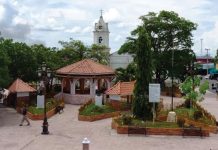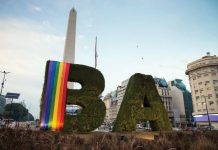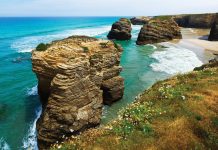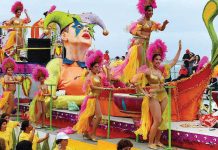Aruba es cuna de bellos y espectaculares paisajes y destino turísticos de muchos turistas a nivel mundial es un país autónomo insular del Reino de los Países Bajos —junto a Curazao, Sint Maarten y los Países Bajos—. Se establece en la isla homónima del grupo de Sotavento, perteneciente a las Antillas Menores. El país autónomo se sitúa a 25 km al norte de la península de Paraguaná, al noroeste de Venezuela, al sur del mar Caribe, al este del archipiélago de Los Monjes y la península de la Guajira y al oeste de otro país autónomo neerlandés, Curazao.
Hasta el año 1986 formó parte de las Antillas Neerlandesas (disueltas en 2010) y actualmente no forma parte de la Unión Europea a semejanza de otros territorios de soberanía europea que comparten este estatus, como Groenlandia (Dinamarca), Polinesia Francesa (Francia) e Islas Caimán (Reino Unido). Sin embargo, existen otros territorios exteriores a Europa de soberanía de países de la Unión Europea, que sí son parte integrante de esta, como la Guayana Francesa en Sudamérica. A pesar de ello, todos los ciudadanos de Aruba poseen pasaporte neerlandés, y por ende los arubeños gozan de los mismos derechos que los ciudadanos de la Unión Europea.
España colonizó Aruba desde 1499 por un período aproximado de un siglo. Asimismo, una de las referencias más antiguas sobre el nombre de la isla, se encuentra en el archivo del Registro Público Principal de la ciudad de Caracas (Venezuela). Una Cédula real decretada en noviembre de 1525, otorga a Juan Martín de Ampíes, factor de La Española y fundador de Coro, el derecho a repoblar las islas de Aruba, Islas de los Gigantes y Bonaire. En 1588 se publican en Madrid las Elegías de varones ilustres de Indias, de Juan de Castellanos, poeta, cronista y sacerdote español, que menciona a Juan Martín de Ampíes y las tres Islas. Un documento fechado el 9 de diciembre de 1595 específica que Francisco Montesinos, cura y vicario de “las Islas de Curazao, Aruba y Bonaire” le confería un poder a Pedro Gutiérrez de Lugo, estante en Caracas, para que cobrara de las Reales Cajas de Felipe II, el salario que le correspondía por su oficio de cura y vicario de las islas.
En 1678, en la obra de Exquemelin se constata que los indios en Aruba hablan español y que una vez al año viene un padre de Coro. La isla de Aruba fue conquistada por los Países Bajos, por la Compañía Neerlandesa de las Indias Occidentales, en 1636; y mantuvo su control, por casi dos siglos. En 1805, durante las Guerras Napoleónicas, los británicos mantuvieron brevemente el control de la isla hasta 1816, cuando fue devuelta a los Países Bajos.
El pionero político e iniciador de las revoluciones en América, el general Francisco de Miranda en su intento de penetrar a tierra venezolana por las costas de Coro, llega en 1806 a Aruba con 200 a 300 hombres e imprime en su barco una proclamación dirigida a los habitantes de Aruba, en la cual menciona a Guillermo de Orange, George Washington, Pelópidas y Dion.
En 1828 pasa a control de las Indias Occidentales Danesas, y en 1848 pasa a formar parte de las Antillas Neerlandesas. Durante el siglo XIX hubo una fiebre de oro, y a dicha prosperidad se sumó, la apertura de una refinería de petróleo de la Standard Oil en 1924, en el puerto de San Nicolás, la más grande del mundo para su tiempo. En 1927 se establece en el área de “Druif”, muy cerca del puerto de Oranjestad, el APM (“Eagle Refinery Company”) una filial de la compañía petrolera Shell, que importa el petróleo de Venezuela. Durante la Segunda Guerra Mundial, fueron dos importantes puertos para el abastecimiento de combustible de las fuerzas aliadas que operaban en Europa. Lo que expuso esos dos puertos al asedio de submarinos de la Alemania nazi.
Antes de concluir, tenemos que resaltar la exquisita gastronomía de esta hermosa isla. A continuación te ofrecemos unos platillos muy ricos y reconocidos de esta isla. Empezamos con el delicioso estofado hecho a base de carne de res, pollo o pescado. Este exquisito platillo es servido tradicionalmente con arroz moro y fríjoles o puré de maíz, también llamado funchi. La especialidad de nuestra Isla Feliz está hecha para deleitar a tu paladar. Seguimos con el Segundo En Papiamento disfrutas de todo el sabor del Caribe. Está ubicado en una antigua mansión, en la que puedes apreciar exuberantes jardines tropicales y raras antigüedades al estilo holandés.
Te recomendamos pedir la especialidad de la casa: cazuela de mariscos con finas hierbas y verduras de la huerta, servida en olla de barro. Además tienen filetes asados al horno y la parrilla, que puedes acompañar con los vinos de su bodega.
 Aruba is the birthplace of beautiful and expecting landscapes and tourist destination of many tourists worldwide is an island autonomous country of the Kingdom of the Netherlands – together with Curacao, Sint Maarten and the Netherlands. It is established on the homonymous island of the Sotavento group, belonging to the Lesser Antilles. The autonomous country is located 25 km north of the Paraguaná peninsula, northwest of Venezuela, south of the Caribbean Sea, east of the Los Monjes archipelago and the Guajira peninsula and west of another Dutch autonomous country, Curaçao.
Aruba is the birthplace of beautiful and expecting landscapes and tourist destination of many tourists worldwide is an island autonomous country of the Kingdom of the Netherlands – together with Curacao, Sint Maarten and the Netherlands. It is established on the homonymous island of the Sotavento group, belonging to the Lesser Antilles. The autonomous country is located 25 km north of the Paraguaná peninsula, northwest of Venezuela, south of the Caribbean Sea, east of the Los Monjes archipelago and the Guajira peninsula and west of another Dutch autonomous country, Curaçao.
Until 1986, it was part of the Netherlands Antilles (dissolved in 2010) and is currently not part of the European Union, similar to other territories of European sovereignty that share this status, such as Greenland (Denmark), French Polynesia (France) and Islands. Cayman (United Kingdom). However, there are other territories outside Europe of sovereignty of countries of the European Union, which are an integral part of this, such as French Guiana in South America. Despite this, all citizens of Aruba have a Dutch passport, and therefore Arubans enjoy the same rights as citizens of the European Union.
Spain colonized Aruba from 1499 for a period of approximately one century. Also, one of the oldest references on the name of the island, is in the file of the Main Public Registry of the city of Caracas (Venezuela). A royal decree decreed in November 1525 grants Juan Martín de Ampíes, a factor of La Española and founder of Coro, the right to repopulate the islands of Aruba, the Islands of the Giants and Bonaire. In 1588 the Elegies of Illustrious Men of the Indies, Juan de Castellanos, poet, chronicler and Spanish priest, who mentions Juan Martín de Ampíes and the three Islands, were published in Madrid. A document dated December 9, 1595 specifies that Francisco Montesinos, priest and vicar of “the Islands of Curaçao, Aruba and Bonaire” conferred a power on Pedro Gutiérrez de Lugo, a shelf in Caracas, to collect from the Royal Savings Banks. Felipe II, the salary that corresponded to him for his office of priest and vicar of the islands.
In 1678, in the work of Exquemelin it is noted that the Indians in Aruba speak Spanish and that once a year a father of Coro comes. The island of Aruba was conquered by the Netherlands, by the Dutch Company of the West Indies, in 1636; and maintained its control, for almost two centuries. In 1805, during the Napoleonic Wars, the British briefly maintained control of the island until 1816, when it was returned to the Netherlands.
The political pioneer and initiator of the revolutions in America, General Francisco de Miranda in his attempt to penetrate Venezuelan land along the coasts of Coro, arrives in 1806 to Aruba with 200 to 300 men and prints on his ship a proclamation addressed to the inhabitants of Aruba, in which he mentions William of Orange, George Washington, Pelopidas and Dion.
In 1828 it passes to control of the Danish West Indies, and in 1848 it becomes part of the Netherlands Antilles. During the nineteenth century there was a gold rush, and to that prosperity was added, the opening of an oil refinery of Standard Oil in 1924, in the port of San Nicolás, the largest in the world for its time. In 1927, the APM (“Eagle Refinery Company”), a subsidiary of the oil company Shell, which imports Venezuelan oil, was established in the “Druif” area, very close to the port of Oranjestad. During World War II, they were two important ports for the fuel supply of the allied forces operating in Europe. What exposed those two ports to the siege of submarines of Nazi Germany.
Before concluding we have to highlight the gastronomic ski of this beautiful island. Next a couple of very rich and recognized dishes of this island. Let’s start with stews made with beef, chicken or fish. This exquisite dish is traditionally served with Moorish rice and beans or corn purée, also called funchi. The specialty of our Happy Island is made to delight your palate. Segment with the Second In Papiamento you enjoy all the flavor of the Caribbean. It is located in an old mansion, where you can appreciate lush tropical gardens and rare antiquities in the Dutch style.
We recommend ordering the specialty of the house: seafood casserole with fine herbs and vegetables from the garden, served in a clay pot. They also have grilled steaks baked and grilled, which you can accompany with the wines from your cellar.
















